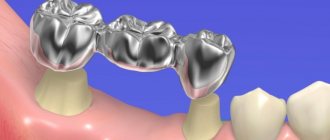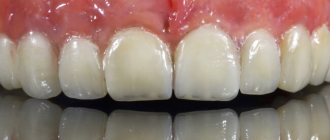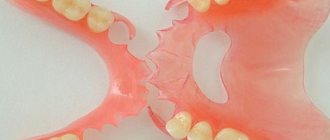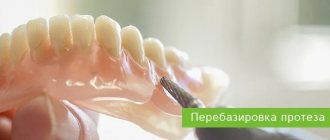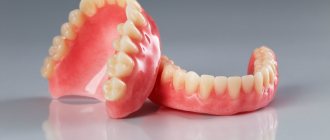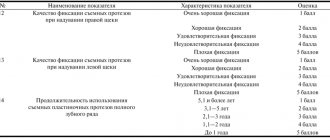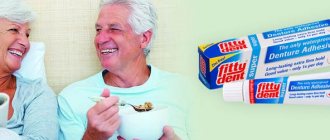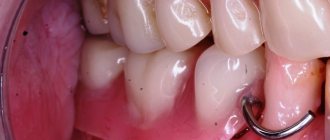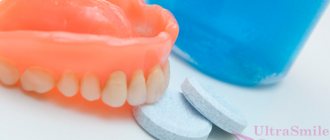Children's dental prosthetics is an opportunity to quickly restore a damaged, lost or missing primary or permanent bite unit. The dental procedure takes 20-40 minutes and is suitable for children of almost any age.
Any tooth loss before the child reaches 6 years of age is considered abnormal and requires urgent solution to the problem.
The lack of timely prosthetics leads to problems with chewing and speech, and provokes the development of bite pathologies.
Why does a child need dentures?
Many parents think that there is nothing wrong with a child missing several teeth until the permanent ones appear. However, ignoring the problem leads to dysfunctions of the child’s body:
- difficulties in sound pronunciation. The teeth are involved in the formation of sounds, the child will adapt and after the radical elements grow, he will begin to pronounce words incorrectly - a speech defect is obvious;
- gastrointestinal diseases - poorly chewed food, injures the mucous membrane of the organs of the system, leads to the development of local diseases, poor absorption of useful components;
- malocclusion - when a child loses a tooth early, other chewing units take its place, the molar has nowhere to grow - it grows out of the row. The result is that a malocclusion is formed, an aesthetic defect and psychological discomfort appear.
A dental prosthesis for a child is designed to temporarily replace the missing element and help avoid unpleasant consequences.
How plates are made and put on
The treatment process begins according to the following algorithm:
- The orthodontist makes impressions of one or both jaws.
- X-ray control is carried out.
- A fitting of the preliminary plaster version is scheduled.
- A permanent plate model is made.
It is important that the plastic frame fully displays the relief pattern of the dentition. The metal parts are designed to provide the most reliable fixation.
When the plates are installed on the patient, he does not experience pain. The only difficulty at first may be related to speech, to clearly pronouncing individual sounds. Also at first there is likely to be increased salivation. However, this should pass in just a couple of days.
When is prosthetics indicated?
Dental prosthetics in children is carried out under the following circumstances:
- the tooth is affected by caries and cannot be restored;
- the element has broken off at the level of the base, root;
- tissues affected by fluorosis;
- bone inflammation has been diagnosed, in which tooth extraction is inevitable;
- periodontitis has been identified as the cause of unit mobility;
- the child has bruxism;
- the patient has underdeveloped enamel or other local congenital pathologies.
What is the price of a dental plate?
A plate for straightening teeth is the most inexpensive way to correct a bite. With this method of treatment, the doctor does not have to stick a bracket on each tooth, which takes quite a lot of time and money. Adjusting the plate also takes much less time than adjusting each bracket individually.
Quite often, thanks to just one plate, the bite can be completely corrected. If the problem was too serious, there is a chance that the patient will still have to wear braces during adolescence. However, the duration of wearing them will be significantly less than if the child did without the plate in childhood - which means the cost of orthodontic services will also be lower.
ATTENTION:
After wearing fixed braces during adolescence, wearing a plate may be necessary to consolidate the effect. This will not depend on whether the child wore the record as a child.
Types of children's dentures
Depending on the transferred functions (purpose), a children's denture for baby teeth can be removable or non-removable.
Removable prosthetics
The defining characteristic of the products is the ability to remove the structure without the help of a doctor, if circumstances so require. They are made from a homogeneous material or several are combined. In the practice of pediatric dentistry the following is used:
- bridge prosthesis. Needed to replace defects of considerable extent (3 or more). Typically, the product is made from different types of plastics. It is possible to use metal to create fixing elements or individual parts of the structure;
- plate prosthesis. The product consists of a plastic base and fasteners. It can be stationary or sliding. The same type of structures is effective in orthodontic therapy in correcting bite pathologies and aligning individual elements in a row;
- immediate prosthesis or “butterfly”. One-piece thermoplastic nylon base structure. This is a crown, complemented by clasps that “cling” to adjacent units and fix the prosthesis in place. Typically, such a design is installed if a child has lost one “milk jug” due to injury.
Fixed prosthetics
Fixed dental prosthetics for children is important in cases where partial defects need to be restored (the child’s tooth remains in place). We are talking about products such as:
- tab. Fixed orthopedic structures help to “resurrect” the destroyed tooth crown while preserving the pulp and tooth root. In other words, this is a volumetric filling that replaces the destroyed part of the tooth, preserving the anatomical shape of the unit;
- pin tab. Installation of a prosthesis is indicated when the nerve is damaged and its resection is necessary, as well as when the crown is almost completely destroyed and the root is preserved. The doctor fixes the pin carefully, without damaging the thin root walls. The pins are made of chromium-nickel or gold alloys, the crown is “finished” with porcelain or plastic facets;
- crown. A metal structure that replaces the crown part of a decayed tooth. In this case, chromium-nickel alloy or medical steel is used;
- Strip crown is a transparent product. It is used for injuries, carious lesions, and bruxism. The “cap” is made of transparent acrylic; the filling composition plays a secondary role.
Dental prosthetics with crowns for children: indications
Children's dental prosthetics in Moscow are performed according to indications. Each situation is considered by the doctor individually, taking into account the patient’s age, health characteristics and other criteria.
Indications for prosthetics are:
- Destruction of the coronal part by half or even more - due to injuries, caries, pulpitis.
- Non-carious lesions, problems with tooth enamel in children - hypoplasia, aplasia, fluorosis.
- Removal of a baby tooth long before the start of a change in bite or permanent one.
- Gum and periodontal diseases - loosening and loss of teeth due to periodontitis, periodontitis.
- Injuries to the teeth and maxillofacial region - severe damage, chipped enamel, complete dislocation.
- Bruxism is involuntary grinding of teeth, causing deformation, destruction, and tooth loss.
- Anomalies and malformations - absence of primordia of mammary and permanent units, cleft lip and palate and other genetic abnormalities.
- Adentia - complete or partial, caused by hereditary or objective factors.
Prosthetic dental crowns for a child will help solve the problem of missing one or more units.
What should prostheses be like for children?
Children's dental prostheses must meet increased requirements, namely:
- do not interfere with the formation of children's speech and diction;
- be aesthetically pleasing and extremely easy to use;
- do not cause allergies, do not have a toxic effect on the child’s body;
- do not injure the oral mucosa;
- have minimal shrinkage and swelling;
- be resistant to plaque formation.
It is not always possible to eliminate all the negative effects of prostheses on the child’s body. In such cases, they make a choice in favor of those products that cause minimal damage.
How to care for the plate
The removable product must be removed before eating, playing sports or intense physical activity. The product should not be removed while sleeping, as this will delay the treatment process. As for whether it is necessary to remove the device while eating, there is no clear answer: the doctor will have to make an individual recommendation. It should be taken into account that most plates can be stained by food.
The record must be stored in a special sealed container, which will be provided by the orthodontist. Wrapping the device in a cloth or paper napkin is strictly prohibited: practice shows that you are likely to break it or accidentally throw it away.
Clean the plate twice a day, after waking up and before going to bed. To do this, it will be enough to use a regular toothbrush and toothpaste. Many brands produce specialized liquid and tablets for the care of such devices.
ATTENTION:
When cleaning, you need to pay special attention to the places where the screws are located. This is where food debris most often accumulates and creates a favorable environment for the proliferation of pathogenic microorganisms.
During the day, you should rinse your mouth as often as possible to eliminate bacterial plaque that contributes to the development of caries. You should brush your teeth in the morning and evening while wearing the plate especially long and thoroughly. If tartar is found on the device, you should inform your treating specialist, and he will give advice on how to remove it.
Progress of prosthetics
Regardless of the type of prosthetic structure, the procedure includes the following steps:
- examination, consultation;
- diagnostics - conduct a survey, examine the child (take an x-ray);
- preparation for fixation of the prosthesis. If necessary, treat the tooth;
- taking impressions;
- product production;
- fitting and installation of the prosthesis.
Before fixing any type of product, general preparation of the unit is required - organizing professional cleaning of the enamel layer.
How long do you wear a dental plate?
Typically, teeth straightening plates are worn for 6 months to 1 year. It all depends on the individual characteristics of the bite, as well as the regularity and duration of wearing the product.
The period of getting used to the plate lasts about 2 weeks. First, the orthodontist makes the product according to individual measurements and shows the little patient where her clasp feet are located and how to use them. Children should learn to put on and take off the plate themselves from the very beginning. However, the less they wear it and the more often they take it off, the longer the treatment will last. Parents should explain to the child that removing the plate is only allowed for a short time.
Under no circumstances should the plate compress or injure the teeth. The force exerted by it remains minimal throughout its wearing. The child should never experience pain or suffer from constricted circulation inside the mouth. The duration of wearing is primarily due to the fact that the teeth move into the correct positions smoothly and gradually. They will then need some time to “get used to” their new places.
ATTENTION:
During the course of treatment, the child will need to be brought to the clinic for examination once every 1-2 months.
Why is it safe to install children’s prostheses in Stokos?
The Stokos Clinic in St. Petersburg works tirelessly to ensure that young patients and their parents feel calm and comfortable within our walls. Our doctors are trusted because with us:
- reliable. Stokos Dentistry employs experienced, certified doctors who approach business wisely and never act according to a template;
- calmly. Our dentists know how to make the child comfortable with themselves and the process - parents do not have to worry about their child;
- comfortable. Our staff is always polite to those who contact us, smiling and prompt in taking action;
- inexpensive. We set fair prices for services.
Make an appointment with our doctor right now - because here, with us, sincere smiles are born!
Reviews
Cvetlana R
01/07/2022 at 15:38
We have been going to this dentistry for a long time. We are seeing O.A. Hristova. Very good doctor, friendly and attentive. He quickly finds a common language with children.
Alexandra Aladina
01/06/2022 at 10:11
Doctors are experts in their field. Price-quality corresponds 100%
Danil V.
01/05/2022 at 17:49
I constantly take my son to the dental clinic, check his teeth and treat them. There is also an adult department at this address - all the staff are super!
Alexey Lyule
12/29/2021 at 10:19
Cool clinic, doctors and staff are masters of their craft. Well done to the staff, the prices are reasonable.
Alexey Lazarichev
12/26/2021 at 19:44
Excellent clinic, they put braces on my daughter, she liked everything!
Lyubov H.
12/24/2021 at 08:58
We entrusted the child with the first dental treatment and did not regret it, the doctor established contact with the child, gave anesthesia (injection), which the child did not even understand! Just a delight, thank you))
Vitaly
12/19/2021 at 22:01
Everything is fine.
Natalya Pogodina
11/28/2021 at 12:33 pm
Attentive doctors. Very nice staff. I only take my kids there
Svetlana Aladeva
27.11.2021 at 20:23
The best clinic with more than 20 years of experience, they work with professionals, so it can be difficult to make an appointment. Polite staff, modern equipment and sterilization of instruments.
Irina Kalashnikova
20.11.2021 at 11:07
Great center. I contacted my eldest daughter and they helped. Now we are correcting the bite of the youngest. Positive dynamics of treatment. The doctors know their stuff. Many thanks to artodontist Alexandra Mikhailovna Potryasova and Alana Borisovna.
Sergey Marchenko
08.11.2021 at 09:47
A very good clinic, competent and responsive staff, the best approach to children that I have seen.
Yulia Kuznetsova
07.11.2021 at 09:47
Many thanks to Dr. Larisa Vladimirovna and Galina Vladimirovna. You are true masters of your craft.
Sergey Shpenev
10/14/2021 at 14:02
Great.
DD
09.10.2021 at 00:16
Qualitatively and reliably, honestly and correctly. It’s good that I know that such dentistry exists! I think I'm lucky.
Kira Ivanova
06.10.2021 at 14:16
Good pediatric dentistry
Dmitry Chmarov
09.13.2021 at 11:44
The prices are not great, but at least the child is not afraid to go. They pulled out baby teeth that were deeply embedded and the child never felt pain
Anna
09/12/2021 at 00:26
Excellent children's orthodontist, prices are very reasonable, focus on treating the child, not on pumping out money like in many other places, the result is really visible, thank you, prosperity to the clinic
Dmitry Surovy
08/22/2021 at 15:38
Excellent pediatric dentistry! I really enjoyed all three visits! They came twice to remove pigmentation, once for a routine examination. The 2.5 year old child behaved calmly and fearlessly. After visiting they give you a gift))) I recommend it to everyone!
Alla I.
08/04/2021 at 14:37
We have been seeing the clinic for a long time, about 6 years, with the same dentist-therapist. I like the quality and service. Sometimes we visit a hygienist until we find a doctor who would suit us 100%. At first, the two-year-old child was very afraid to have his teeth treated, but the doctors at the clinic managed to find an approach. And they saved all our teeth.
Natalya F.
03.08.2021 at 17:01
We treat our teeth with Dr. Nenko. A very excellent doctor. My child was scared at 2 years old in a regular clinic so that he cried when he heard the word from the dentist. And he went to Alexander Vladimirovich with a smile. And now he is already 13 years old, but he only goes to him. I am very grateful to this doctor. Thank you very much !!! And regarding the prices. Damn, the prices are stinging right now. I'm not a millionaire. But wherever I was, the child was not treated better than in cramming. And really...
All reviews
Prescription of prophylactic prostheses
Artificial structures are installed to solve the following orthopedic and surgical problems:
– immobilization of mandibular joint mobility;
– correction and strengthening of the dental arch;
– functional replacement of lost teeth, psychological comfort of the patient;
– compensation of articulatory balance;
– prevention of the development of pathologies of the dental system, atrophy of the alveolar processes;
– stimulation of jaw bone growth;
– therapy of mandibular dislocation or subluxation caused by trauma, malocclusion, rheumatism, arthrosis, arthritis and other pathologies;
– prevention of occlusal disorders during the rehabilitation period after installation of osteoplastic structures, implants, periodontal surgery, treatment of injuries, etc.
